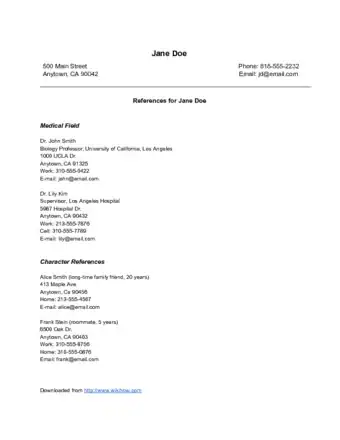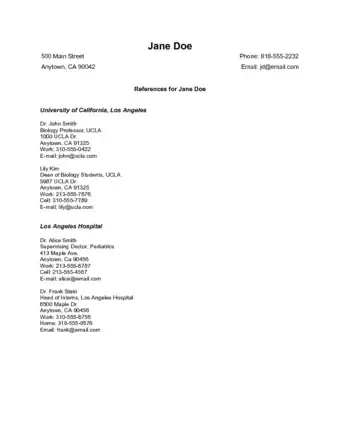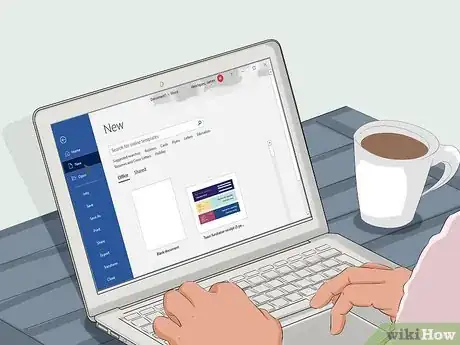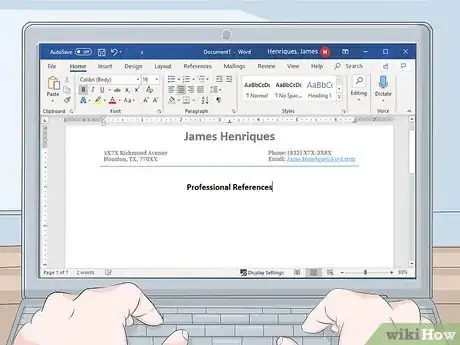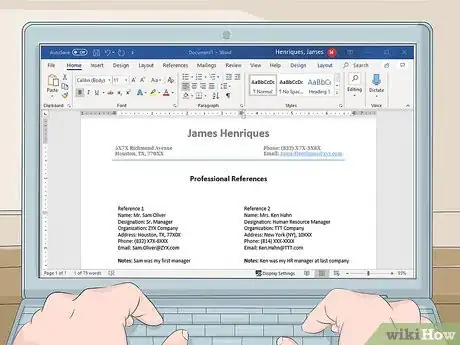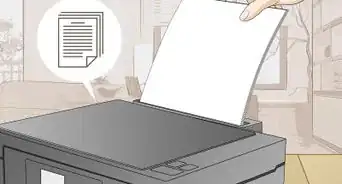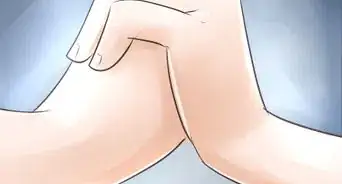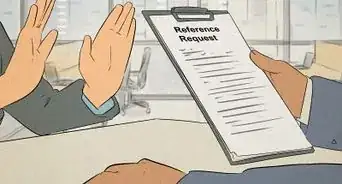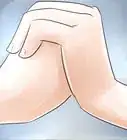This article was co-authored by Adrian Klaphaak, CPCC. Adrian Klaphaak is a career coach and founder of A Path That Fits, a mindfulness-based boutique career and life coaching company in the San Francisco Bay Area. He is also is an accredited Co-Active Professional Coach (CPCC). Klaphaak has used his training with the Coaches Training Institute, Hakomi Somatic Psychology and Internal Family Systems Therapy (IFS) to help thousands of people build successful careers and live more purposeful lives.
This article has been viewed 3,564,515 times.
Many potential employers ask for a list of references in a job application or at the end of a job interview. That’s why it’s a good idea to have a list of references handy when you’re applying for a new job.
Steps
Sample Documents
Making a Reference List
-
1Make sure your references know that you will be using them as references. Do not give out their contact information to potential employers unless they give you their explicit permission.[1]
- When asking your references for permission to give out their contact information, make sure that they plan on giving a positive recommendation.
- It’s also a good idea to ask your references how they would prefer to be contacted (ex. email, work phone, cell phone, etc.).
-
2Use a separate page for your references. You don't need to have "References available upon request" at the bottom of your resume. Employers will assume you have references and will ask for them specifically - usually at the end of the hiring process.
- Unless you are applying to be a nanny, personal assistant, or something with a similar level of one-on-one interaction, the main body of your resume should not even mention references.
Advertisement -
3Start your reference list with a heading. The heading should include your name in a clear, bold font. In a slightly smaller font beneath that, you should include your address, phone number, and email. For aesthetic reasons, you can align your contact information to the opposite corner, as below.[2]
- You may also want to add a line underneath the heading in order to clearly separate it from the rest of the document. If you include a line, choose one that is simple and elegant.
- For a more cohesive, professional look, maintain the same style and formatting that you used in your resume.
-
4Under the heading, add a clear title. The title should be in a slightly larger font - about the same size as your name is in the header.
- Choose a simple, clear title that reflects the content of the page. "Professional References for (Your Name)" is a good example.
-
5List your references and their relevant information. There are no hard rules for what order to list your references. It can be handy to list your "best" references first - that is, references that are extremely positive and that have worked with you for the longest.[3]
- Begin your reference list by listing the name of the first reference in bold. In the line beneath that, write their relationship to you and the company you both worked at.
- Include the work address beneath that – provided that they still work at the company where you both worked together; If they do not, leave the work address out and remember to check to make sure that your contact information is current.
- If your reference has agreed to be contacted by phone, list the phone number next. Remember to indicate whether the number is for a work phone or cell phone.
- If your reference has agreed to be contacted by email, include the e-mail last (as email is less personal than a phone call).
-
6Format any additional references in a similar way. If you have experience in multiple fields of work, breaking your reference list into several subsections, one for each field, will make the page easier to read for your employer.
- Keep in mind that references that you gained while working in a field of work that differs greatly from the one you are applying for shouldn't be listed.
Expert Q&A
Did you know you can get premium answers for this article?
Unlock premium answers by supporting wikiHow
-
QuestionShould I tell my references what to include?
 Adrian Klaphaak, CPCCAdrian Klaphaak is a career coach and founder of A Path That Fits, a mindfulness-based boutique career and life coaching company in the San Francisco Bay Area. He is also is an accredited Co-Active Professional Coach (CPCC). Klaphaak has used his training with the Coaches Training Institute, Hakomi Somatic Psychology and Internal Family Systems Therapy (IFS) to help thousands of people build successful careers and live more purposeful lives.
Adrian Klaphaak, CPCCAdrian Klaphaak is a career coach and founder of A Path That Fits, a mindfulness-based boutique career and life coaching company in the San Francisco Bay Area. He is also is an accredited Co-Active Professional Coach (CPCC). Klaphaak has used his training with the Coaches Training Institute, Hakomi Somatic Psychology and Internal Family Systems Therapy (IFS) to help thousands of people build successful careers and live more purposeful lives.
Career Coach
-
QuestionWho should I use as a reference if I have no experience?
 Adrian Klaphaak, CPCCAdrian Klaphaak is a career coach and founder of A Path That Fits, a mindfulness-based boutique career and life coaching company in the San Francisco Bay Area. He is also is an accredited Co-Active Professional Coach (CPCC). Klaphaak has used his training with the Coaches Training Institute, Hakomi Somatic Psychology and Internal Family Systems Therapy (IFS) to help thousands of people build successful careers and live more purposeful lives.
Adrian Klaphaak, CPCCAdrian Klaphaak is a career coach and founder of A Path That Fits, a mindfulness-based boutique career and life coaching company in the San Francisco Bay Area. He is also is an accredited Co-Active Professional Coach (CPCC). Klaphaak has used his training with the Coaches Training Institute, Hakomi Somatic Psychology and Internal Family Systems Therapy (IFS) to help thousands of people build successful careers and live more purposeful lives.
Career Coach
-
QuestionIs it OK to put references available upon request?
 wikiHow Staff EditorThis answer was written by one of our trained team of researchers who validated it for accuracy and comprehensiveness.
wikiHow Staff EditorThis answer was written by one of our trained team of researchers who validated it for accuracy and comprehensiveness.
Staff Answer wikiHow Staff EditorStaff Answer
wikiHow Staff EditorStaff Answer
Warnings
- Make sure you have accurate contact information listed for your references. Your reference's career status changes, too - they may have a new work email or a new phone.⧼thumbs_response⧽
- Don't provide references too early in the process. Your contacts will not want to be bothered by numerous phone calls or e-mails until you are certain that you’re interested in the position and/or have been singled out as an especially likely candidate. Protect their privacy above all.⧼thumbs_response⧽
- Though you shouldn't include references on your main resume, you are generally expected to include them on a curriculum vitae (CV) if you live in the U.S. Consult our wikiHow on How to Write a CV for more information. Note that this also varies by country, e.g., many English-speaking EU countries use a CV in nearly all contexts, and references aren't expected in most circumstances.[5]⧼thumbs_response⧽
- Don't list family members or personal friends as references - even as character references. This is unprofessional and can give the impression that you don't have legitimate references.[6]⧼thumbs_response⧽
References
- ↑ Adrian Klaphaak, CPCC. Career Coach. Expert Interview. 18 December 2018.
- ↑ https://www.indeed.com/career-advice/resumes-cover-letters/resume-reference-list
- ↑ https://icc.ucdavis.edu/materials/references
- ↑ Adrian Klaphaak, CPCC. Career Coach. Expert Interview. 18 December 2018.
- ↑ https://theundercoverrecruiter.com/cv-vs-resume-difference-and-when-use-which/
- ↑ https://www.monster.com/career-advice/article/whats-wrong-with-personal-reference
About This Article
Before you put references on your resume, email or call them and ask for permission. Once you’ve gotten their permission, make a separate document for your references that isn’t the main page of your resume. Put contact information at the top and include a title like “References for Gabriel Grey.” List your references and include their name, relationship to you, job title, work address, and phone number or email. For more tips on including your references with your resume, like how to structure your references page, read on!
